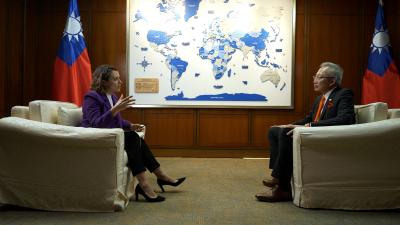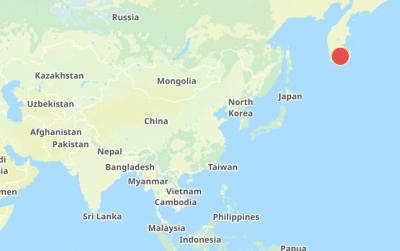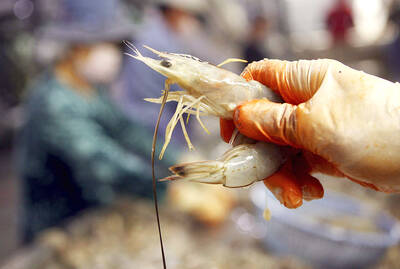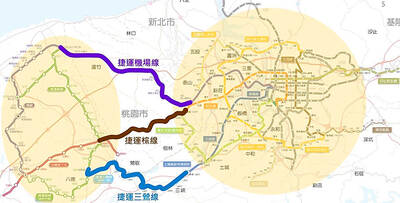Was there a serious US-Chinese naval confrontation in the Taiwan Strait in November, or wasn't there? Nobody, it seems, knows for sure.
But reports of such a confrontation sped across the Pacific Ocean to the US with the speed of modern Internet communications this week and the story seemed to get bigger at each step along the way.
Finally, it was officially denied, but the denial was itself considered suspect by some observers and the issue may not be dead.
It started when the Chinese-language China Times reported on Tuesday that the aircraft carrier USS Kitty Hawk and its battle group was intercepted in the Strait by the Chinese guided missile warship, the Shenzhen, and a Song-class submarine, after being denied entry to Hong Kong for a Thanksgiving visit.
The US ships were heading to their home port of Yokosuka Naval Base in Japan through the Strait when the incident occurred, the China Times reported. Accosted by the Chinese vessels, the Kitty Hawk stopped and "assumed a combat position," and the confrontation lasted more than two days before each side stepped down, the paper said.
Indeed, the Shenzhen was heading in the same direction as the Kitty Hawk at the time and landed at Yokosuka on a courtesy call at about the same time as did the Kitty Hawk, to become the first Chinese warship to visit Japan since World War II.
Japan's Kyodo news bureau in Taipei, on Thursday, did a story on the China Times report, which in turn was picked up by the Navy Times. Japanese newspapers ran similar stories.
From there, the story spread like wildfire.
Within hours, US congressional staffers and others in Washington were asking Taiwanese reporters about the incident, which became the talk of the Taiwan media in the US capital.
Then, in a "news" story that appeared to assume the worst, Fox TV network news picked up the story, with its newsreader commenting that the reported standoff was "serious."
By the time Fox aired the report, the commander of US forces in the Pacific, Admiral Timothy Keating, had already denied the story as totally false, as did the Pentagon's East Asia spokesman, Stewart Upton, in Washington.
Nevertheless, a grave-faced Fox newsreader told viewers: "We are now hearing about a serious showdown between a US battle group and the Chinese Navy ... some kind of incident between US warships and a Chinese attack submarine and destroyer."
"This is serious," she said.
Punctuating the report was an interview with a Fox military analyst, Lieutenant General Tim McInerney, who speculated that there was "a little game going on here," between the US and Chinese navies, going on to explain why and how the confrontation could have occurred.
As the general delivered his scenario commentary, the screen was filled with Kitty Hawk file film of warships firing missiles and destroying enemy vessels at sea and ships in various war formations, under a foreboding sky.
No place in the report did the general or the newsreader note that the original story might be wrong. Nor did the broadcast indicate that the station had tried to confirm or deny the report.

“China is preparing to invade Taiwan,” Deputy Minister of Foreign Affairs Francois Wu (吳志中) said in an exclusive interview with British media channel Sky News for a special report titled, “Is Taiwan ready for a Chinese invasion?” the Ministry of Foreign Affairs said today in a statement. The 25-minute-long special report by Helen Ann-Smith released yesterday saw Sky News travel to Penghu, Taoyuan and Taipei to discuss the possibility of a Chinese invasion and how Taiwan is preparing for an attack. The film observed emergency response drills, interviewed baseball fans at the Taipei Dome on their views of US President

The Central Weather Administration (CWA) today issued a "tsunami watch" alert after a magnitude 8.7 earthquake struck off the Kamchatka Peninsula in northeastern Russia earlier in the morning. The quake struck off the east coast of the Kamchatka Peninsula at 7:25am (Taiwan time) at a depth of about 19km, the CWA said, citing figures from the Pacific Tsunami Warning Center. The CWA's Seismological Center said preliminary assessments indicate that a tsunami could reach Taiwan's coastal areas by 1:18pm today. The CWA urged residents along the coast to stay alert and take necessary precautions as waves as high as 1m could hit the southeastern

ECONOMIC BENEFITS: The imports from Belize would replace those from Honduras, whose shrimp exports have dropped 67 percent since cutting ties in 2023 Maintaining ties with Taiwan has economic benefits, Ministry of Foreign Affairs officials said yesterday, citing the approval of frozen whiteleg shrimp imports from Belize by the Food and Drug Administration (FDA) as an example. The FDA on Wednesday approved the tariff-free imports from Belize after the whiteleg shrimp passed the Systematic Inspection of Imported Food, which would continue to boost mutual trade, the ministry said. Taiwan’s annual consumption of whiteleg shrimps stands at 30,000 tonnes, far exceeding domestic production, the ministry said. Taiwan used to fill the gap by importing shrimps from Honduras, but purchases slumped after Tegucigalpa severed diplomatic ties with Taiwan

The Executive Yuan yesterday approved a southwestern extension of the Sanying MRT Line from New Taipei to Bade District (八德) in Taoyuan, with a goal of starting construction by late 2026. The 4.03-kilometer extension, featuring three new stations, will run from the current terminus at Yingtao Fude Station (LB12) in New Taipei City to Dannan Station (LB14), where it will connect with Taoyuan’s Green Line, New Taipei City Metro Corp said in a statement. This extension will follow the completion of core Sanying Line, a 14.29-kilometer medium-capacity system linking Tucheng (土城), Sansia (三峽)